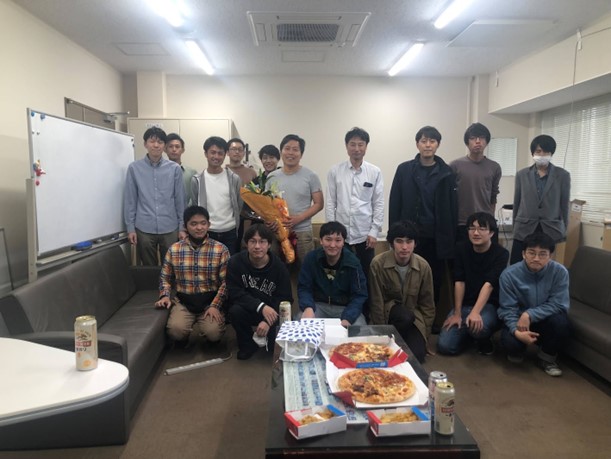In Spring 2023, I embarked on a transformative three-month sabbatical in Japan supported in part by the Japan Society for the Promotion of Science short term invitation fellowship. This essay captures the most memorable moments of my time there—both in the laboratory and amidst the vibrant cultural tapestry of Japan—in the hope of inspiring my fellow JSPS alumni members to return to this remarkable country.
My name is Xin Fan and I was a newly tenured Physics professor at the University of Denver at the time. My journey to Japan was not a solo venture; my wife and our two young daughters joined me, and together, we dove headfirst into an adventure that would forever shape our perspectives. The food, culture, and stunning landscapes became a source of endless delight for all of us.
Research: A Symphony of Collaboration
My academic home during this sabbatical was the Ono Group located within the Institute of Chemical Research at Kyoto University, where Professor (and long-time friend) Moriyama Takahiro served as my host. From the beginning, he generously assisted me with the JSPS fellowship application process, making the transition smooth and welcoming. I was struck by the warm reception and the intense dedication of everyone I met. The group’s commons room even had a bed – a quiet testament to the long hours graduate students often dedicated to their research. I marveled at their resilience and passion, and their work ethic inspired me to push my own boundaries.

One of the most exhilarating moments came from an idea I had for years but couldn’t pursue due to a lack of equipment. When I shared this idea with Prof. Shiota Yoichi, I expected it might take weeks for us to test it. Instead, by the very next morning, he had performed a proof-of-concept experiment with promising results.
The momentum was unstoppable. With the help of graduate student Kobayashi Yuta and Prof. Yang Bo, we constructed a new experimental setup within three days—a pace unheard of in my usual workflow. Over the next month, we gathered enough data to draft a paper. It was research at its most dynamic: fast, collaborative, and deeply satisfying.
Sakura and Sunrises: Kyoto’s Timeless Beauty
Kyoto in the spring is a city transformed by sakura—the delicate cherry blossoms that blanket the streets, temples, and riversides in shades of white and pink. The timing of our sabbatical felt serendipitous. To beat the crowds, we decided to embrace early mornings, setting out at 6:30 a.m. to explore iconic places, including the Fushimi Jukkokubune and the serene gardens of Kiyomizu-dera.

These early adventures became treasured family moments. The air was crisp, the streets were quiet, and the blossoms seemed to glow in the soft morning light. My daughters delighted in running beneath the trees, their laughter blending with the gentle rustle of petals in the wind. By 9 a.m., I was back in the lab, energized by the tranquility of the morning and ready to immerse myself in research.
Navigating the Language Barrier
English is not widely spoken in Japan, but we navigated the country with ease thanks to AI-powered translation tools. From deciphering menus to asking for directions, these tools were invaluable in bridging the language gap. My ability to read Mandarin also came in handy when interpreting maps and signs, as many of them are written in Kanji.

However, relying on my Mandarin skills wasn’t foolproof—it occasionally led to amusing misunderstandings. Once, we set out to buy sake and specifically wanted something sweet. Spotting a box labeled “糖質ゼロ”, I confidently interpreted it as containing sugar, since the first two characters mean “sugar” in Mandarin. What I missed was the meaning of the last two characters, “ゼロ” (Katakana for “zero”). The sake turned out to be dry, much to our surprise when we tasted it! Moments like this became cherished anecdotes, adding a touch of humor to our journey.
A Cultural Feast
Beyond the laboratory and the blossoms, Japan offered a daily feast for the senses. From savoring the subtle flavors of a perfectly crafted bowl of ramen to exploring the ancient streets of Gion, every experience was layered with beauty and tradition. My daughters quickly developed a fondness for Dango (rice cake), which became our go-to snack during weekend excursions.
We also discovered the joys of Japanese hospitality. One weekend, Prof. Moriyama Takahiro invited us to a tea ceremony, where we learned the delicate rituals of whisking matcha. It was a moment of stillness and grace, a window into the heart of Japanese culture.
Reflections
My sabbatical in Japan was much more than a professional milestone—it was a personal and family journey that deepened my appreciation for science, culture, and the value of global collaboration. The meticulousness of Japanese researchers inspired me to rethink how I approach my own work, while the cultural richness reminded me of the joy of discovery, both in and outside the lab.
For anyone contemplating a sabbatical in Japan, my advice is simple: go. Bring your family if you can. Let yourself be immersed in the discipline of Japanese research and the beauty of its traditions. You will leave with not only new data and ideas but also memories that will shape you for years to come.
back to Stories from Japan
